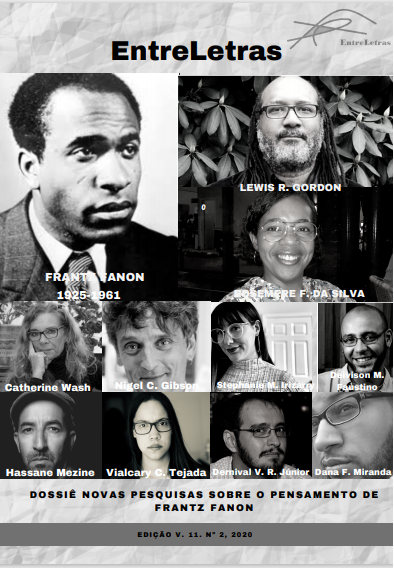THE EXISTENCE OF A NOVOHISPANIC COLLECTIVE CONSCIOUSNESS IN ALBOROTO Y MOTÍN DE INDIOS DE MÉXICO
DOI :
https://doi.org/10.20873/uft.2179-3948.2020v11n2p207Mots-clés :
Alboroto y motín, Carlos de Sigüenza y Góngora, Gaspar de la Cerda, motín 1692, Nueva España, México, pulqueRésumé
This research paper analyses how Carlos de Sigüenza y Góngora describes the pair fest-revolt in Alboroto y motín de indios de México. This study is divided into five parts. The first one takes as its starting point the concept of the polis and regulations for the common good. The second one alludes to the effect that Spanish splendor produces in the different members of the Novohispanic polis. The third part examines the active role of female Indigenous in the revolt’s organization and development. Finally, in the fifth part, I propose the existence of a plebeian collective consciousness within the viceroyalty of New Spain.
Téléchargements
Références
ARANA PÉREZ, F. J. Letrados, juristas y burócratas en la España Moderna. Cuenca: Universidad de Castilla La Mancha, 2005.
ARGAN, C. G. L’Europa delle capitali: 1600-1800. Lausana: Fabbri Skira, 1964.
BACHINI, A. Gli antichi Romani. Florencia: Giunti Editore, 2011.
BARCIA, R. Conversaciones con el pueblo español. Madrid: Biblioteca revolucionaria, 1869.
BERCE, Y-M. Fête et révolte: des mentalités populaires du XVIe au XVIIIe siècle. París : Hachette, 1994.
BORNEMANN, M M. and R. Aguirre Salvador. Los indios, el sacerdocio y la Universidad en Nueva España, siglos XVI-XVIII. México: UNAM, 2006.
BOTERO, G. Della ragion di Stato. Roma: Donzelli Editore, 1997.
COPE, R. D. 1994. The limits of racial domination: Plebeian society in colonial Mexico City, 1660–1720. Madison: University of Wisconsin Press, 1994.
CORTÉS TOVAR, R. “Misoginia y literatura: la tradición greco-romana”. Feminismo del pasado al presente. Salamanca. Ediciones Universidad de Salamanca, 2000, pp. 15-34.
COSTIGAN, L. H. "Literatura, meio-ambiente e questões sócio-antropolôgicas: letrados barrocos e intelectuais pós-modernos." Revista Iberoamericana, 1997, (63.181), pp. 607-620.
CRUZ PAZOS, P. “Cabildos y cacicazgos: alianza y confrontación en los pueblos indios novohispanos”. Revista Española de Antropología Americana, 2004, (34), pp. 149-162.
HANSEN, J. A. "Barroco, neobarroco e outras ruínas." Virreinatos I. México. Destiempos, 2008, pp. 169-215.
MANDROU, R. "Les soulèvements populaires et la société française du XVIIe siècle." Annales, 1959, (14), pp. 756-765.
MERRIM, S. The spectacular city, Mexico, and colonial Hispanic literary culture. University of Texas Press, 2012.
PILLORGET, R. Les mouvements insurrectionnels de Provence entre 1595 et 1715. París. Presses Universitaires de France, 1975.
PRAT RODRÍGUEZ AGUILERA, C. "La teoría del Estado en la España de los Austrias." Revista de estudios políticos, 1983, (36), pp. 131-158.
RAAFLAUB, K. A. "Polis, ‘the Political’, and Political Thought: New Departures in Ancient Greece, c 800–500 BCE." Axial civilizations and world history. Leiden-Boston. Brill, 2005, pp. 253-283.
RAMA, Á. La ciudad letrada. Cali. Ediciones del norte. 1984.
ROJAS, J. L. Cambiar para que yo no cambie: la nobleza indígena en la Nueva España. Buenos Aires. Sb editorial, 2016.
ROMERO GONZÁLEZ, D. "La Asamblea de mujeres de Aristófanes,¿ mezcla de realidad y ficción?." Ámbitos: revista de Estudios de Ciencias Sociales y Humanidades, 2004, (11), pp. 11-17
ROUNDS, J. “The role of the tecuhtli in ancient Aztec society”. Ethnohistory, 1977, (24.4), pp. 343-361.
SEGRETO, V. "Alle radici dell'unità politica: polis, parola, conflitto." Vita, politica, contingenza. Macerata. Quodlibet, 2016, pp. 139-148.
SEMO, E. Historia del capitalismo en México. México. Secretaría de Educación Pública. 1985.
SIGÜENZA Y GÓNGORA, Carlos de. Seis obras. Caracas. Fundación Biblioteca Ayacucho. 1984.
SOLOGUREN, J. “La ciudad inculpada” Obras completes de Javier Sologuren. Lima. Pontificia Universidad Católica del Perú, 2004, (VII), pp. 503-530
THOMPSON, E. P. 1971. "The moral economy of the English crowd in the eighteenth century." Past & present, 1971, (50), pp. 76-136.
TILLY, L. A. "La révolte frumentaire, forme de conflit politique en France." In Annales. Histoire, Sciences Sociales, 1972, (27.3), pp. 731-757.
TOVAR DE TERESA, G. El Pegaso, o, El mundo barroco novohispano en el siglo XVII. Sevilla. Editorial Renacimiento. 2006.
TURNER, V. 1980. "Social dramas and stories about them." Critical inquirí, 1980, (7. 1), pp. 141-168.
WIDIASTUTI, S/N. 2003. “El enfoque de la ciudad: ni este, ni oeste: oposiciones que hay que superar en la historia de los enfoques de la ciudad (Reflexiones desde Bali)”. Unidad y diversidad del pensamiento geográfico en el mundo. Retos y perspectivas. México. INEGI-UNAM, 2003, pp. 223-233.
Téléchargements
Publié-e
Comment citer
Numéro
Rubrique
Licence
Os autores mantêm os direitos autorais e concedem à revista o direito de primeira publicação, com o trabalho simultaneamente licenciado sob a Creative Commons 4.0 que permite o compartilhamento do trabalho com reconhecimento da autoria do trabalho e publicação inicial nesta revista.
Os autores têm autorização para assumir contratos adicionais separadamente, para distribuição não-exclusiva da versão do trabalho publicada nesta revista (ex.: publicar em repositório institucional ou como capítulo de livro), com reconhecimento de autoria e publicação inicial nesta revista.










